Grim's
Dyke Rehabilitation Unit
Old Redding, Harrow Weald, Harrow,
Middlesex HA3 6SH
Medical
dates:
Medical
character:
Rehabilitation (tuberculosis)
In 1937 Grim's Dyke, a
country mansion with 40 acres of grounds and woodlands, was purchased
by the Middlesex County Council. It became the Grimsdyke
Institution, a rehabilitation centre for women suffering from TB.
The Institution closed in 1939, at the outbreak of WW2, and the premises were used for unstated military purposes (the information is classified and not due for release until the 2040s).
During an air-raid in July 1943, the property suffered minor blast damage from exploding bombs and mines. The leaded lights of the house and the windows in the greenhouse were broken, and a drainpipe fractured. Four craters were left in a nearby field.
After the war the building reopened as a rehabilitation centre for both men and women with TB. It had 50 beds.
In July 1948 Middlesex County Council leased the Grim's Dyke estate to the North West Metropolitan Regional Hospital Board for 21 years, at an annual rent of £835, with a full repairing tenancy.
The Grim's Dyke Rehabilitation Unit opened in 1948 under the control of the Charing Cross Hospital Management Committee. Now, only male patients with TB were admitted.
The patients were ambulant and semi-ambulant convalescents who had been discharged from a sanatorium or hospital after active treatment. Most had spent 12 weeks on bed rest following surgical treatment, but it was felt they no longer needed a strict hospital routine for a further 12-week graded rehabilitation. Thus, the Rehabilitation Unit served the purpose of providing a bridge between a hospital ward and a return to family and work life. During the three months of their stay, patients were encouraged to undertake an increasing amount of outdoor work under careful clinical supervision. During inclement weather, they were given indoor occupations.
Patients kept regular hours of work, but were granted more personal freedom. They were allowed to leave the Unit in the evenings, but had to return by 21.00 hr, and could spend alternate weekends at home. In this way, they could become physically and psychologically prepared before returning to normal employment in industry. Before they were discharged, arrangements were made for them to return to their previous employment or, alternatively, a new job was found.
In 1959 the Unit, which had been placed under control of Charing Cross Hospital, was transferred to the Harefield and Northwood Group Hospital Management Committee. (It had been planned to build the new Charing Cross Hospital at Northwick Park, but it was built instead on the site of Fulham Hospital in Hammersmith, while a new large district general hospital was built at Northwick Park).
In 1962 the Regional Hospital Board decided to close the Unit and to surrender the lease early.
The Rehabilitation Unit closed in March 1963.
Present status (August 2008)
The Institution closed in 1939, at the outbreak of WW2, and the premises were used for unstated military purposes (the information is classified and not due for release until the 2040s).
During an air-raid in July 1943, the property suffered minor blast damage from exploding bombs and mines. The leaded lights of the house and the windows in the greenhouse were broken, and a drainpipe fractured. Four craters were left in a nearby field.
After the war the building reopened as a rehabilitation centre for both men and women with TB. It had 50 beds.
In July 1948 Middlesex County Council leased the Grim's Dyke estate to the North West Metropolitan Regional Hospital Board for 21 years, at an annual rent of £835, with a full repairing tenancy.
The Grim's Dyke Rehabilitation Unit opened in 1948 under the control of the Charing Cross Hospital Management Committee. Now, only male patients with TB were admitted.
The patients were ambulant and semi-ambulant convalescents who had been discharged from a sanatorium or hospital after active treatment. Most had spent 12 weeks on bed rest following surgical treatment, but it was felt they no longer needed a strict hospital routine for a further 12-week graded rehabilitation. Thus, the Rehabilitation Unit served the purpose of providing a bridge between a hospital ward and a return to family and work life. During the three months of their stay, patients were encouraged to undertake an increasing amount of outdoor work under careful clinical supervision. During inclement weather, they were given indoor occupations.
Patients kept regular hours of work, but were granted more personal freedom. They were allowed to leave the Unit in the evenings, but had to return by 21.00 hr, and could spend alternate weekends at home. In this way, they could become physically and psychologically prepared before returning to normal employment in industry. Before they were discharged, arrangements were made for them to return to their previous employment or, alternatively, a new job was found.
In 1959 the Unit, which had been placed under control of Charing Cross Hospital, was transferred to the Harefield and Northwood Group Hospital Management Committee. (It had been planned to build the new Charing Cross Hospital at Northwick Park, but it was built instead on the site of Fulham Hospital in Hammersmith, while a new large district general hospital was built at Northwick Park).
In 1962 the Regional Hospital Board decided to close the Unit and to surrender the lease early.
The Rehabilitation Unit closed in March 1963.
Present status (August 2008)
After the premises were vacated, they were used as a location for films and TV programmes until 1968, then converted into a hotel, opening on 5th April 1970 as the Grim's Dyke Hotel and Country Club.
In 1996 the Grade II listed building underwent extensive restoration and refurbishment.
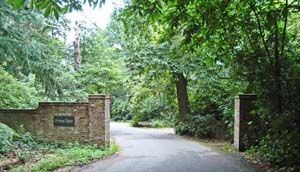
The main entrance drive to the Grim's Dyke Hotel.
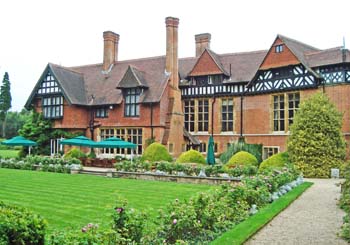
The southern elevation (above and below). The house was designed in the domestic Tudor style, with a rambling plan, tall chimneys and many half-timbered gables.
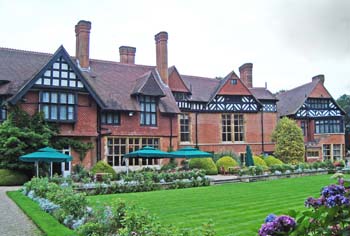
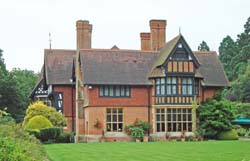
The western elevation.
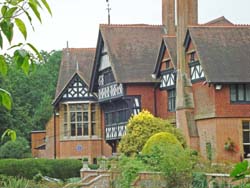
The northern elevation.
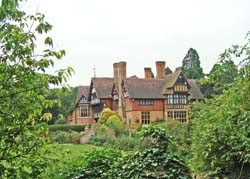
The building, as seen from the west.
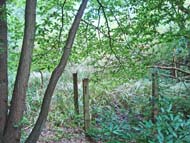
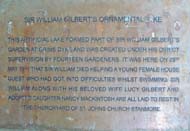
The boating lake (left) was filled in by Lady Gilbert following the death of her husband. A memorial plaque (right) states:
SIR WILLIAM GILBERT'S ORNAMENTAL LAKE
This artificial lake formed part of Sir William Gilbert's garden at Grims Dyke and was created under his direct supervision by fourteen gardeners. It was here on 29th May 1911 that Sir William died helping a young female house guest who had got into difficulties whilst swimming. Sir William along with his beloved wife Lucy Gilbert and adopted daughter Nancy Mackintosh are all laid to rest in the churchyard of St John's Church Stanmore.

An impressive redwood in the grounds.
Grim's Dyke has been bought for £4,000 in 1890 by the dramatist and librettist W.S. Gilbert, of Gilbert and Sullivan fame. The house had been designed by Norman Shaw (who had also designed New Scotland Yard) and had been built in 1872 for Frederick Goodall, R.A.
On 29th May 1911, Gilbert suffered a heart attack and drowned in his boating lake while attempting to rescue a local girl, Ruby Preece, who had got into difficulties while swimming.
Lady Gilbert continued to live in the house, doing local charity work, until her death in 1936. The house and its contents were sold in 1937.
Houghton LE 1954 The general management of the phthisical patient from the phyisican's standpoint. Postgraduate Medical Journal 30, 278-282.
http://archiseek.com
http://en.wikipedia.org
http://openbuildings.com
http://thelondonloopwalk.blogspot.co.uk
http://worldofbuildings.worldofbuildings.org
www.british-history.ac.uk
www.grimsdyke.com
www.harrow.gov.uk
www.imagesofengland.org.uk (1)
www.imagesofengland.org.uk (2)
Return to home page